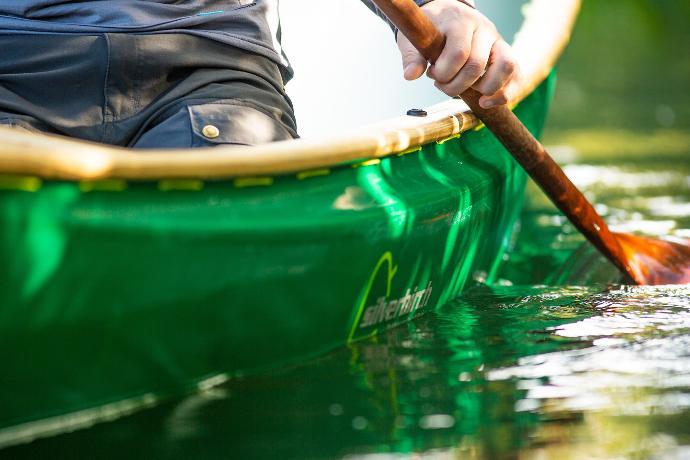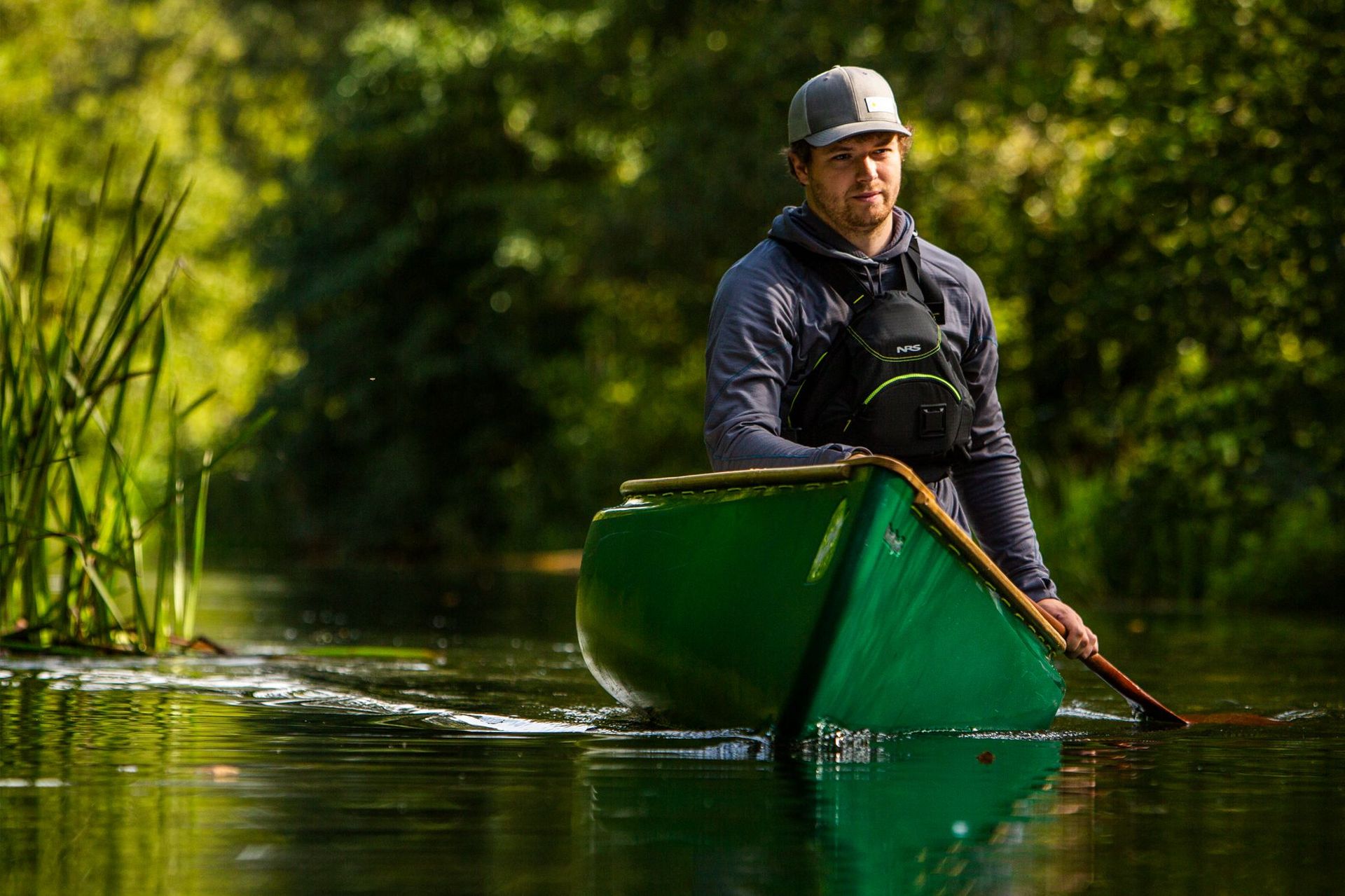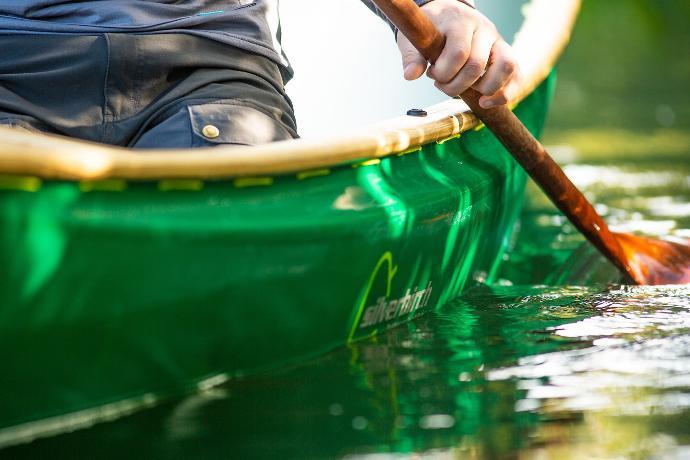At some point, we cross a line between trim level, which is mostly a matter of aesthetics, and outfitting, which is mostly a matter of practicality. In practice, the two tend to be inseparable!
AESTHETICS, VERSATILITY, OR BOTH?
For some, a major part of the attraction of a traditional canoe is the minimalist look and versatility of a bare boat with heritage and design connections to classic birchbark or wood-and-canvas boats from a very different era.
For others, the versatility that comes with a kneeling thwart, sailing fittings and deep dish carrying yokes opens up possibilities for using the same craft in ever more style and comfort, and in more varied environments.
If we want minimalist lines and maximum versatility, we can sometimes go with "removable" trim: the best of both worlds? Or the master of none?

Nothing will ever top a dedicated set-up for efficiency and effectiveness, but having everything permanently fitted ensures the weight has to be carried at all times. Of course, making components removable can also create issues. One classic is stowing components when they are not in use, either on or away from the water.
Omitting any optional thwarts certainly keeps the interior of any canoe as open as possible, ready for loading with a picnic wannigan, a portage pack, canoe barrels, firewood, four-legged-friends, or anything else… but without these fittings, our options can be limited!

KNEELING THWARTS
If solo-canoeing a tandem open canoe is part of what appeals about canoeing, and is likely to feature prominently in our experiences, we might see a carefully-positioned central seat or kneeling thwart as a high priority.
If solo-canoeing in a tandem open canoe is going to be rare occurrence, and will only be in benign conditions, we might choose to improvise our seating arrangement, perhaps using existing tandem seats or a removable saddle.
For open water solo canoeing in a tandem canoe, replacing the fixed yoke with a more central seat or kneeling thwart can be advantageous, allowing the canoeist's weight to be over the centre of the canoe.
For solo whitewater canoeing, kneeling thwarts positioned 33-40cm (13"-16") behind the yoke of a tandem canoe are conventional. Entire coaching schemes have developed around skills to operate this way, and by shifting canoe packs or other weight forward in the canoe, the positioning of the canoeist behind the yoke can be made to work on open water, including in strong winds.
In the event of a capsize, clearance above the floor of the canoe and in front of the kneeling thwart might become critical. Some canoeists prefer a quick release kneeling thwart and/or yoke. Any arrangement should be thoroughly tested, but with any solution, canoeists should consider carrying a pruning saw capable of sawing through any woodwork.
CARRYING YOKES
For some, yokes are structural parts of the hull. They may also be considered as practical aids, to be used on every canoe trip. Where they are fitted, such yokes tend to be the visual centrepiece of any traditional canoe.
Anyone who tells you portaging is fun is either a liar or crazy…

If a yoke is rarely (if ever) going to be used in anger (for solo-carrying) then a standard yoke may suffice… but deep-dish yokes are vastly more comfortable, and the aesthetics of a well-finished Ash, Cherry or Ash and Cherry (two tone) deep dish yoke can be striking. For longer portages, consider clamp on yoke pads.
For those who go solo in an open canoe, a removable yoke allows optimum seat or kneeling-thwart positioning, with the weight of the paddler right over the centre of buoyancy of the canoe. Removable yokes should be stowed to one side whilst afloat.

SAILING THWARTS AND SEATS
Pretty much everyone who gets out and about regularly in a canoe will eventually end up harnessing the wind in some way, shape or form.
Progressing beyond downwind sailing with a large umbrella or improvised wind-catcher generally requires some sort of mast. This commonly leads canoeists to fit an adapted seat or specialist thwart.
Adapted seats typically support masts from lower down than specialist sailing thwarts. This puts more strain through the seat, and seats tend to be weaker (and more expensive) than dedicated sailing thwarts.
Please note: most basic sailing thwarts provide an upper-anchor for the mast and only work if paired with an appropriate mast foot: a block (typically of wood or plastic) which locates the end of the mast on the floor of the canoe. Bonding on mast feet generally needs to be capable of taking significant sheer forces.
The forces created by a large sailing rig in strong winds can be big enough to bend or break any non-specialist fitting, and can even bend a canoe out of shape. Contact the UK based Open Canoe Sailing Group for examples of tried and tested solutions, up to and including Leeboard Thwarts, Leeboards and Rudders.
ENDCAPS, ENDLOOPS, LACING, ETC…
At some point, we have to stop talking of trim levels and start talking of outfitting. That might be when we go from discussing endcaps (polyethlene, wooden, or otherwise) to endloops (lengths of easily replaced rope).
Factory outfitting that could be considered as part of the trim level might include end-lacing (for fitting flotation) and full-length lacing (providing additional attachment points all along the gunwales).
Custom lacing might be offered for the fitting of removable decks, but splash-decks and spray-decks are more commonly retro-fitted.

D-Rings are the most customisable canoe outfitting feature that could be offered as part of a manufacturer's "trim level" offering. These can be placed pretty much anywhere and may serve as part of a strap-system (locating knees) or, for tying down flotation bags and blocks.
Although individuals may leave them permanently attached to canoes, items such as mounts for trolling motors are generally removable: they are accessories rather than part of part of the trim level. See the Silverbirch Canoes Accessory Guide for examples of such products.


The Trim of the Canoe, Part III: Thwarts, etc.